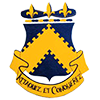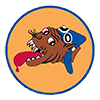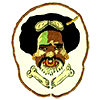USAAF 8th Pursuit Group (Interceptor) - 8th Fighter GroupAuthorized on the inactive list as 8th Pursuit Group on 24 Mar 1923. Activated on 1 Apr 1931. Redesignated 8th Pursuit Group (Fighter) in 1939, and 8th Pursuit Group (Interceptor) in 1941. Trained, took part in maneuvers and reviews, and tested planes and equipment, using PB-2, P-6, P-12, P-35, P-36, P-39, and P-40 aircraft prior to World War II. In Dec 1941, became part of the defense force for the New York metropolitan area. Moved to the Asiatic-Pacific Theater early in 1942. Redesignated 8th Fighter Group in May 1942. Became part of Fifth AF. Equipped first with P-39's, added P-38's and P-40's in 1943, and used P-38's after May 1944.
Established headquarters in Australia in Mar 1942 but sent detachments to New Guinea for operations. Moved to New Guinea in Sep 1942 and served in combat until malaria forced the organization to withdraw to Australia in Feb 1943. Resumed operations in Apr 1943 and served in the theater through the rest of the war. Covered Allied landings, escorted bombers, and attacked enemy airfields in New Guinea; supported operations of the US Marines at Cape Gloucester, Feb-Mar 1944; flew long-range escort and attack missions to Borneo, Ceram, Halmahera, and the southern Philippines; provided cover for convoys, attacked enemy shipping, and won a DUC for strafing a strong Japanese naval force off Mindoro (26 Dec 1944) covered landings at Lingayen; supported ground forces on Luzon; escorted bombers to targets on the Asiatic mainland and on Formosa; and, in the last days of the war, attacked airfields and railways in Japan. Remained in the theater after V-J Day, being based in Japan for duty with Far East Air Forces. Converted to P-51's early in 1946 and to F-80's early in 1950. Redesignated 8th Fighter-Bomber Group in Jan 1950.
Began operations in the Korean War on 26 Jun 1950 by providing cover for the evacuation of US personnel from Seoul. Entered combat the following day. Shifted to F-51 aircraft in Oct 1950 but converted back to F-80's in Dec 1950. Began operating from bases in Korea in Oct 1950, but resumed operations from Japan in Dec 1950 when Communist forces drove far south in Korea. Returned to Korea in Jun 1951. Served in combat until the end of the war, supporting UN ground forces and attacking such targets as airfields, supply lines, and troop concentrations. Maj Charles Loring Jr was awarded the Medal of Honor for his action on 22 Nov 1952: after his plane had been hit and badly crippled as he was leading a flight of four F-80's against enemy artillery at Sniper Ridge, Maj Loring deliberately dived his plane into the gun emplacements. The group converted to F-86's in the spring of 1953 and returned to Japan the following year.
33d FS - 35th FS - 36th FS - 55th FS - 55th FS - 68th FS - 80th FS - 80th FS
Squadrons. 33d: 1932-1941. 35th: 1932-. 36th: 1931, 1932-. 55th: 1931-1932. 68th: 1945-1947. 80th: 1942-1945, 1947-.
Stations. Langley Field, Va, 1 Apr 1931; Mitchel Field, NY, c. 5 Nov 1940-26 Jan 1942; Brisbane, Australia, 6 Mar 1942; Townsville, Australia, 29 Jul 1942; Milne Bay, New Guinea, 18 Sep 1942; Mareeba, Australia, Feb 1943; Port Moresby, New Guinea, 16 May 1943; Finschhafen, New Guinea, 23 Dec 1943; Cape Gloucester, New Britain, c. 20 Feb 1944; Nadzab, New Guinea, 14 Mar 1944; Owi, Schouten Islands, 17 Jun 1944; Morotai, 19 Sep 1944; San Jose, Mindoro, 20 Dec 1944; Ie Shima, 6 Aug 1945; Fukuoka, Japan, 22 Nov 1945; Ashiya, Japan, 20 May 1946; Itazuke, Japan, Sep 1946; Ashiya, Japan, 13 Apr 1947; Itazuke, Japan, 25 Mar 1949; Tsuiki, Japan, 11 Aug 1950; Suwon, Korea, 7 Oct 1950; Kimpo, Korea, 28 Oct 1950; Pyongyang, Korea, 25 Nov 1950; Seoul, Korea, 3 Dec 1950; Itazuke, Japan, 10 Dec 1950; Kimpo, Korea, 25 Jun 1951; Suwon, Korea, 24 Aug 1951; Itazuke, Japan, 20 Oct 1954-.
Commanders. Unkn, 1931-1932; Maj Byron Q Jones, 25 Jun 1932; Capt Albert M Guidera, 31 Mar 1934; Lt Col Adlai H Gilkeson, 1 Jul 1935; Lt Col William E Kepner, 7 Jul 1938; Lt Col Edward M Morris, 1 Feb 1940; Lt Col Frederic H Smith Jr, 17 Jan 1941; Lt Col William H Wise, 22 May 1942; Lt Col Leonard B Storm, 8 Mar 1943; Lt Col Philip H Greasley, 10 Apr 1943; Lt Col Emmett S Davis, 18 Jan 1944; Lt Col Philip H Greasley, 28 Jun 1944; Col Earl H Dunham, 8 Aug 1944; Lt Col Emmett S Davis, 16 Jun 1945; Lt Col Robert L Harriger, Dec 1945; Lt Col Fergus C Fay, 24 May 1946; Lt Col Luther H Richmond, Jul 1946; Col Stanley R Stewart, Feb 1947; Col Henry G Thorne Jr, 12 Apr 1947; Col Charles T Olmstead, c. 28 May 1948; Lt Col Richard C Banbury, 18 Aug 1948; Lt Col Woodrow W Ramsey, 18 Mar 1949; Lt Col Charles D Chitty Jr, 21 May 1949; Col William T Samways, 1 May 1950; Col Edward O McComas, 19 May 1951; Col Harvey L Case Jr, 31 Jul 1951; Col Levi R Chase, 22 Jan 1952; Col Walter G Benz Jr, 12 Sep 1952; Col John L Locke, 16 Sep 1953; Lt Col Walter A Rosenfield, 13 May 1954; Col Woodrow B Wilmot, 16 Jul 1954-.
Campaigns. World War II: East Indies; Air Offensive, Japan; China Defensive; Papua; New Guinea; Bismarck Archipelago; Western Pacific; Leyte; Luzon; Southern Philippines. Korean War: UN Defensive; UN Offensive; CCF Intervention; 1st UN Counteroffensive; CCF Spring Offensive; UN Summer-Fall Offensive; Second Korean Winter; Korea Summer-Fall, 1952; Third Korean Winter; Korea Summer-Fall, 1953.
Decorations. Distinguished Unit Citations: Papua, [Sep] 1942-23 Jan 1943; Philippine Islands, 26 Dec 1944; Korea, 16 Sep-2 Nov 1950. Philippine Presidential Unit Citation. Republic of Korea Presidential Unit Citations: 27 Jun 1950-31 Jan 1951; 1 Feb 1951-31 Mar 1953.
Insigne. Shield: Azure, a chevron nebule or. Crest: On a wreath of the colors (or and azure) three fleur-de-lis or in front of a propeller fesswise azure. Motto: Attaquez Et Conquerez - Attack and Conquer. (Approved 6 Sep 1934.)
USAAF 8th Pursuit Group (Interceptor) - 33rd Fighter Squadron33rd Fighter Squadron
World War II
Activated as a World War I Army Air Service Aero Squadron at Kelly Field, Texas. Deployed to France in late 1917. Constructed facilities, maintained aircraft, and functioned as a flying training unit. Inactivated in 1919. Reorganized in 1923, activated in 1932 by the Army Air Corps at Langley Field, Virginia. Equipped with a variety of biplane pursuit aircraft, later Northrup A-17A dive bombers. Upgraded to modern Curtiss P-40 Warhawks in 1940, deployed to Iceland when the United States assumed military defense of the Danish Colony in 1941. Performed air defense mission in Iceland during World War II, later equipped with P-39 Aircobras and P-47 Thunderbolts. Inactivated in June 1945.
Reactivated by Tactical Air Command at Clovis AFB, New Mexico in 1953. Never made operational and inactivated after a few weeks. Again reactivated at Myrtle Beach AFB, SC in 1956 as a training squadron. Never made operational and inactivated again after a few weeks.
Reactivated a third time by Tactical Air Command in 1969 at Shaw AFB, SC as an RF-4C Phantom II reconnaissance training squadron. Performed training for new photo-reconnaissance pilots at Shaw until parent wing converted to F-16 Fighting Falcon fighter aircraft, became an operational squadron in 1995, the last of the RF-4C squadrons at Shaw to remain equipped with the Phantom.
Trained in tactical fighter missions designed to destroy enemy forces, 1985-1993. Deployed aircrews and aircraft to Southwest Asia (SWA); participated in Operation Southern Watch over southern Iraq in support of United Nations operations, 1992-1993. Lt Col Gary L. North, commander of 33 Fighter Squadron, became the first F-16 pilot to score an aerial victory in SWA, 27 Dec 1992. Inactivated in late 1993 during switchover from 363d FW to 20th FW.
Reactivated in 2009 at Cannon AFB, New Mexico as a MQ-9 Reaper UAV squadron.
Lineage
Organized as 33d Aero Squadron on 12 Jun 1917
Demobilized on 14 Apr 1919
Reconstituted and redesignated as 33d Pursuit Squadron on 24 Mar 1923
Activated on 25 Jun 1932
Re-designated: 33d Pursuit Squadron (Fighter) on 6 Dec 1939
Re-designated: 33d Pursuit Squadron (Interceptor) on 12 Mar 1941
Re-designated: 33d Fighter Squadron on 15 May 1942
Re-designated: 33d Fighter Squadron, Single Engine on 3 Feb 1944
Inactivated on 22 Jun 1945
Re-designated as 33d Fighter-Bomber Squadron on 3 Mar 1953
Activated on 8 Apr 1953
Inactivated on 25 Jun 1953
Re-designated as 33d Fighter-Day Squadron on 7 May 1956
Activated on 25 Jul 1956
Inactivated on 19 Nov 1956
Re-designated 33d Tactical Reconnaissance Training Squadron on 18 Aug 1969
Organized on 15 October 1969, assuming personnel and equipment of 4415th Combat Crew Training Squadron
Inactivated on 1 Oct 1982
Re-designated 33d Tactical Fighter Squadron on 7 Sep 1984
Activated on 1 Jan 1985
Re-designated 33d Fighter Squadron on 1 Nov 1991
Inactivated on 15 Nov 1993
Re-designated as 33d Special Operations Squadron on 29 Apr 2009
Activated on 29 May 2009.
USAAF 8th Pursuit Group (Interceptor) - 35th Fighter SquadronWorld War II
The 35th Fighter Squadron heritage dates back to 12 June 1917, when the unit activated as the 35th Aero Squadron. Originally an aircraft maintenance squadron, the unit served in France from September 1917 to February 1919. Upon the unit's return to the United States after the armistice, it demobilized during the American disarmament.
Recognizing the need for a strong air arm, American defense officials reconstituted the squadron in June 1932 and redesignated it the 35th Pursuit Squadron. For the next few years, the 35th flew P-12, PB-2, A-17, and P-36 aircraft out of Langley Field, Virginia. In 1939, the unit was redesignated the 35th Pursuit Squadron (Fighter) and moved to Mitchel Field, New York, to fly the P-40 Warhawk.
In March 1942, the newly named 35th Fighter Squadron entered combat in the Pacific. During World War II, its members flew a variety of aircraft, including the P-40 and the P-38 Lightning and accounted for 124 kills. During this time, the unit was based in Australia, New Guinea, Leyte and le Shima. The squadron scored the final American aerial victories of the war on 14 August 1945. By war's end, the 35th moved to Fukuoka Air Base, Japan, to fly P-51 Mustangs.
When the Korean War began, the redesignated 35th Fighter Bomber Squadron entered combat. Once on the offensive, the 35th moved from base to base in Korea, flying the F-80 Shooting Star and later the F-86 Sabre. At one time, the 35th was stationed at Pyongyang, now the capital of North Korea.
When the Korean War ended, the squadron started flying F-100 Super Sabres at its new location at Itazuke Air Base, Japan. In 1963, the squadron received F-105 Thunderchiefs to replace the F-100s and moved to Yokota Air Base, Japan.
In 1964, the 35th deployed to Korat Royal Thai Air Force Base, Thailand, as one of the first units to fight in Southeast Asia. It later moved to Takhli Royal Thai Air Force Base, Thailand. During this deployment, the squadron's new home became Osan Air Base, Republic of Korea.
On 15 March 1972, the 35th moved to Kunsan Air Base to fly the F-4 Phantom II. In September 1981, the 35th and its sister squadron, the 80th Tactical Fighter Squadron, became the first overseas units to convert to the F-16 Fighting Falcon. The squadrons and wing dropped the "tactical" designation from their titles during an Air Force-wide reorganization on 31 January 1992.
On 17 November 2000, the 35th Fighter Squadron received its first Block 40 F-16s. The new aircraft carry Low-Altitude Navigation and Targeting Infrared for Night, or LANTIRN, pods. The combination of LANTIRN and night-vision goggles allows the squadron to take the fight into the night. The 35th completed the conversion in February 2001.
Lineage
Organized as 35th Aero Squadron on 12 Jun 1917
Demobilized on 19 Mar 1919
Reconstituted, and redesignated 35th Pursuit Squadron, on 24 Mar 1923
Activated on 25 Jun 1932
Re-designated: 35th Pursuit Squadron (Fighter) on 6 Dec 1939
Re-designated: 35th Pursuit Squadron (Interceptor) on 12 Mar 1941
Re-designated: 35th Fighter Squadron on 15 May 1942
Re-designated: 35th Fighter Squadron, Two Engine, on 19 Feb 1944
Re-designated: 35th Fighter Squadron, Single Engine, on 8 Jan 1946
Re-designated: 35th Fighter Squadron, Jet, on 1 Jan 1950
Re-designated: 35th Fighter-Bomber Squadron on 20 Jan 1950
Re-designated: 35th Tactical Fighter Squadron on 1 Jul 1958
Re-designated: 35th Fighter Squadron on 3 Feb 1992.
USAAF 8th Pursuit Group (Interceptor) - 36th Fighter Squadron
World War II
During its 90-year history, the 36 FS has flown 21 different types of aircraft, received 22 unit citations and accumulated 24 service and campaign streamers.
The unit came into existence when a group of aviation pioneers, eager to prove the value of air power in World War I, formed the 36th Aero Squadron at Kelly Field, Texas, in June 1917. First Lieutenant Quentin Roosevelt, the son of President Theodore Roosevelt, was one of the squadron's first commanders, assuming command later that year. While the new squadron did not see combat as a unit when it moved to France, several of its members did while flying for other squadrons.
After World War I, the 36th was inactivated, only to be resurrected in October 1930 at Selfridge Field, Michigan, to train pilots and develop new air tactics. In 1932, the 36th relocated to Langley Field, Virginia, as part of the 8th Pursuit Group. While assigned to the 8th, the 36th flew airmail for the U.S. Postal Service, flying in all types of weather without instruments. During World War II, the squadron flew P-40 Warhawk, P-39 Airacobra, P-47 Thunderbolt, and P-38 Lightning fighters in a number of Pacific Theater campaigns. These included the defense of New Guinea and the battle for the Philippines. They moved to Fukuska, Japan at the end of the war.
When the communist forces attacked the Republic of Korea in June 1950, the 36th found itself in the fight from the beginning of the conflict. Flying F-80 Shooting Stars, the squadron attacked advancing North Korean tanks, trucks, artillery, and troops. The unit later converted back to the piston-engined F-51 Mustang, considered more suitable for operations in Korea. The 36th ended the war equipped with F-86 Sabres, flying bombing and strafing missions against enemy air fields. The 36th returned to Japan after the Korean War, operating out of Itazuke Air Base for the next 10 years.
During the Vietnam War, the 36th flew combat missions into Southeast Asia from Korat Royal Thai Air Force Base. 36th pilots flew F-105 Thunderchiefs, escorting rescue aircraft and suppressing anti-aircraft fire. The squadron was re-equipped with F-4 Phantom II fighters in December 1967 and stationed at Yokota Air Base, Japan, with regular deployments to Kunsan Air Base beginning in March 1971. The 36th moved to Kunsan in May 1971, establishing a forward operating location at Osan Air Base. The squadron permanently moved to Osan and was assigned to the 51st Composite Wing (Tactical) in September 1974.
The 36th ushered in the era of the "Viper" on 10 August 1988, when squadron commander Lieutenant Colonel Al Spitzer landed the first F-16 Fighting Falcon at Osan. The squadron's combat capabilities were transformed in 1990 when the squadron converted to the Block 40 Low Altitude Navigational and Targeting Infrared for Night (LANTIRN) F-16C/D. The addition of LANTIRN gave the Fiends the current ability to fly at low levels and deliver precision guided munitions during nighttime conditions. Upgrades to the Block 40 in recent years have included GBU-31 JDAM capability for all weather precision engagement.
Lineage
Organized as 36th Aero Squadron on 12 Jun 1917
Demobilized on 7 Apr 1919
Reconstituted, and redesignated 36th Pursuit Squadron, on 24 Mar 1923
Activated on 2 Oct 1930
Re-designated: 36th Pursuit Squadron (Fighter) on 6 Dec 1939
Re-designated: 36th Pursuit Squadron (Interceptor) on 12 Mar 1941
Re-designated: 36th Fighter Squadron on 15 May 1942
Re-designated: 36th Fighter Squadron, Two Engine, on 19 Feb 1944
Re-designated: 36th Fighter Squadron, Single Engine, on 1 Apr 1946
Re-designated: 36th Fighter Squadron, Jet, on 1 Jan 1950
Re-designated: 36th Fighter-Bomber Squadron on 20 Jan 1950
Re-designated: 36th Tactical Fighter Squadron on 1 Jul 1958
Re-designated: 36th Fighter Squadron on 7 Feb 1992.
Cape Gloucester Airport, West New Britain Province, Papua New Guinea Map Map
 Editor for Asisbiz: Matthew Laird Acred
Editor for Asisbiz: Matthew Laird Acred
If you love our website please add a like on facebook
Please donate so we can make this site even better !!











